Introduction to Economics: Micro and Macro Analysis - University
VerifiedAdded on 2020/04/07
|11
|1412
|319
Homework Assignment
AI Summary
This economics assignment is divided into two parts: microeconomics and macroeconomics. Part A focuses on microeconomic principles, analyzing market equilibrium, and the effects of changes in income and supply on demand. The student uses supply and demand schedules and graphical representations to illustrate these concepts, including the impact of increased income on the demand for TVs and the effects of more suppliers entering the banana market. Part B shifts to macroeconomics, examining the business cycle, its phases, and macroeconomic indicators. The student analyzes China's economic situation in 2006 and 2017, discussing factors influencing aggregate demand, full employment, and inflation, and the impact of these on the economy. The assignment includes references to relevant economic literature.
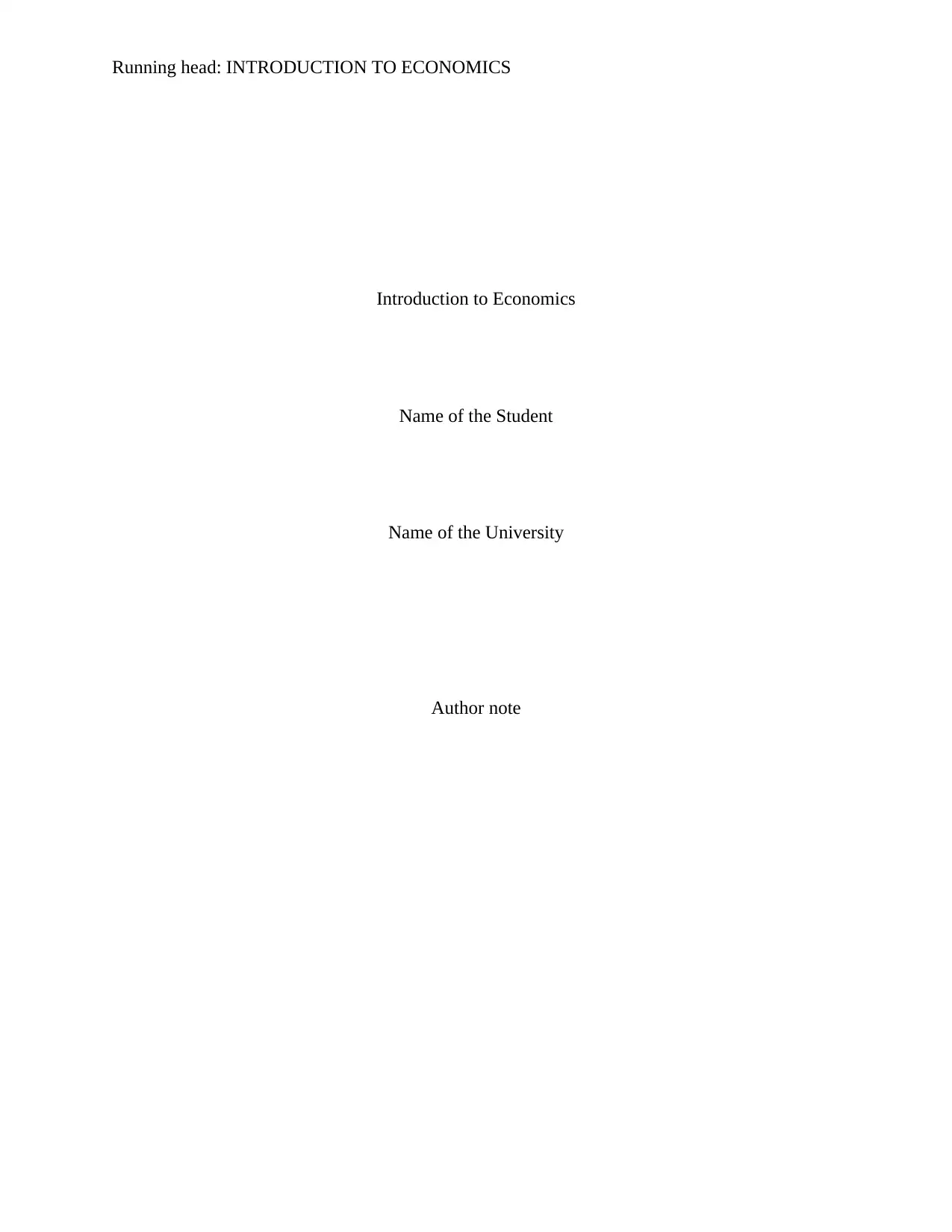
Running head: INTRODUCTION TO ECONOMICS
Introduction to Economics
Name of the Student
Name of the University
Author note
Introduction to Economics
Name of the Student
Name of the University
Author note
Paraphrase This Document
Need a fresh take? Get an instant paraphrase of this document with our AI Paraphraser
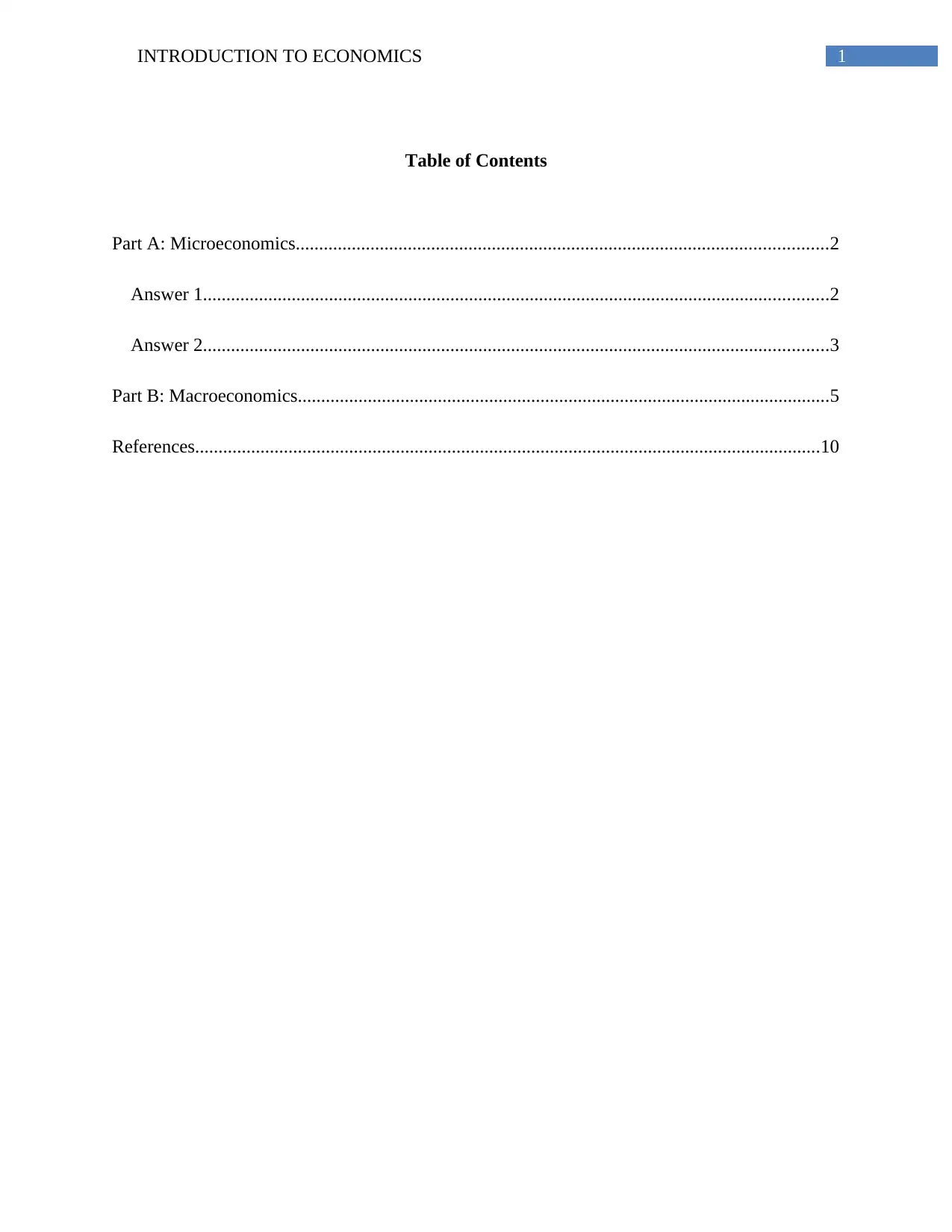
1INTRODUCTION TO ECONOMICS
Table of Contents
Part A: Microeconomics..................................................................................................................2
Answer 1......................................................................................................................................2
Answer 2......................................................................................................................................3
Part B: Macroeconomics..................................................................................................................5
References......................................................................................................................................10
Table of Contents
Part A: Microeconomics..................................................................................................................2
Answer 1......................................................................................................................................2
Answer 2......................................................................................................................................3
Part B: Macroeconomics..................................................................................................................5
References......................................................................................................................................10
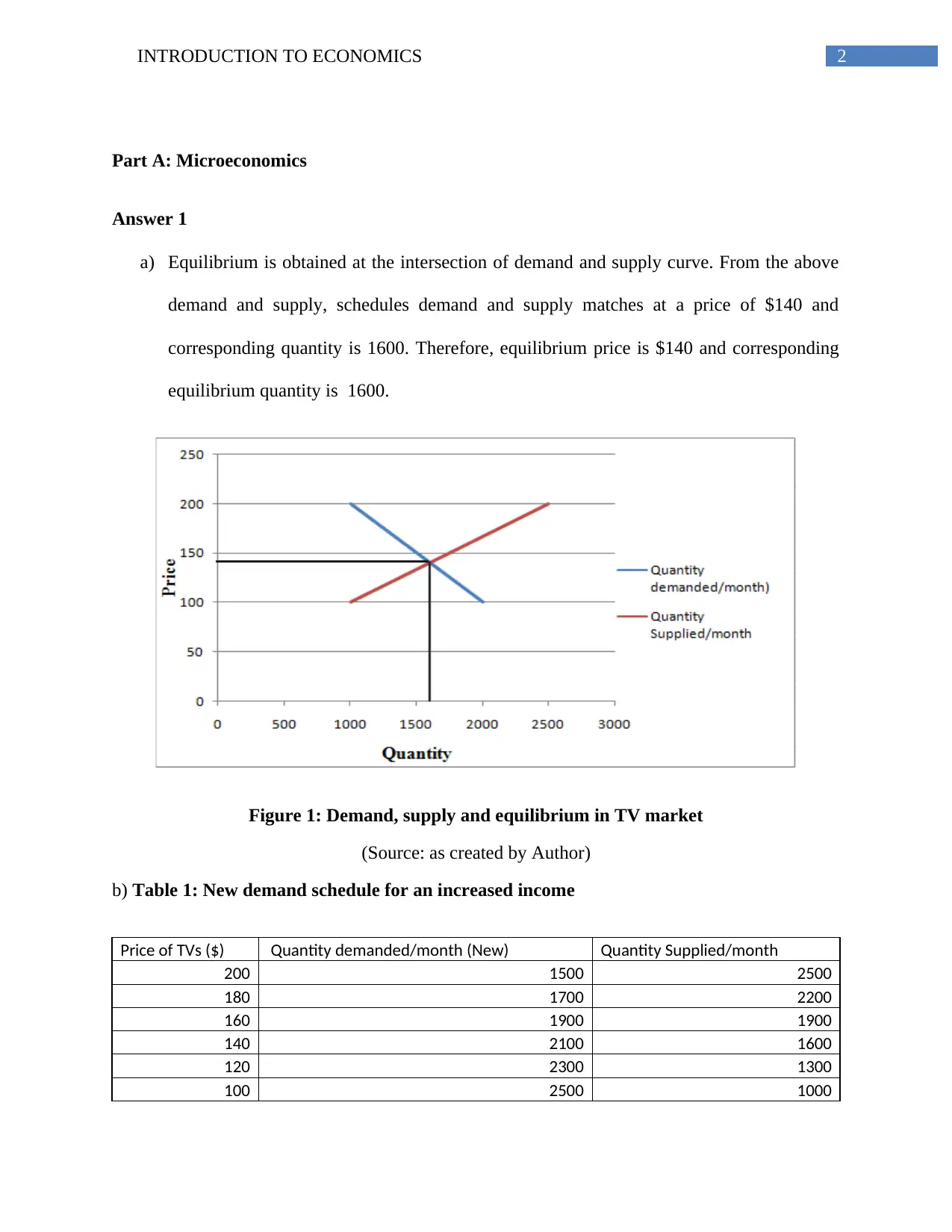
2INTRODUCTION TO ECONOMICS
Part A: Microeconomics
Answer 1
a) Equilibrium is obtained at the intersection of demand and supply curve. From the above
demand and supply, schedules demand and supply matches at a price of $140 and
corresponding quantity is 1600. Therefore, equilibrium price is $140 and corresponding
equilibrium quantity is 1600.
Figure 1: Demand, supply and equilibrium in TV market
(Source: as created by Author)
b) Table 1: New demand schedule for an increased income
Price of TVs ($) Quantity demanded/month (New) Quantity Supplied/month
200 1500 2500
180 1700 2200
160 1900 1900
140 2100 1600
120 2300 1300
100 2500 1000
Part A: Microeconomics
Answer 1
a) Equilibrium is obtained at the intersection of demand and supply curve. From the above
demand and supply, schedules demand and supply matches at a price of $140 and
corresponding quantity is 1600. Therefore, equilibrium price is $140 and corresponding
equilibrium quantity is 1600.
Figure 1: Demand, supply and equilibrium in TV market
(Source: as created by Author)
b) Table 1: New demand schedule for an increased income
Price of TVs ($) Quantity demanded/month (New) Quantity Supplied/month
200 1500 2500
180 1700 2200
160 1900 1900
140 2100 1600
120 2300 1300
100 2500 1000
⊘ This is a preview!⊘
Do you want full access?
Subscribe today to unlock all pages.

Trusted by 1+ million students worldwide
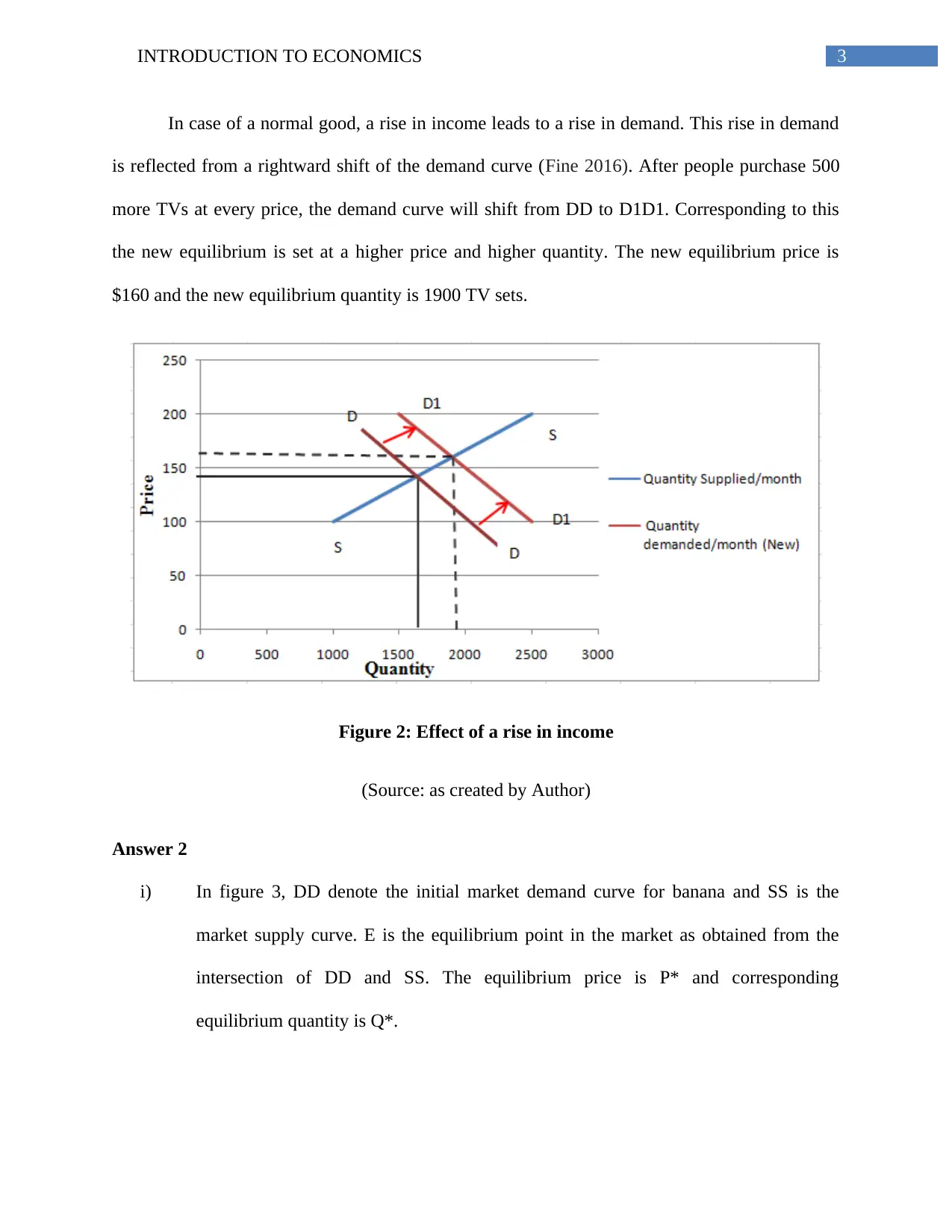
3INTRODUCTION TO ECONOMICS
In case of a normal good, a rise in income leads to a rise in demand. This rise in demand
is reflected from a rightward shift of the demand curve (Fine 2016). After people purchase 500
more TVs at every price, the demand curve will shift from DD to D1D1. Corresponding to this
the new equilibrium is set at a higher price and higher quantity. The new equilibrium price is
$160 and the new equilibrium quantity is 1900 TV sets.
Figure 2: Effect of a rise in income
(Source: as created by Author)
Answer 2
i) In figure 3, DD denote the initial market demand curve for banana and SS is the
market supply curve. E is the equilibrium point in the market as obtained from the
intersection of DD and SS. The equilibrium price is P* and corresponding
equilibrium quantity is Q*.
In case of a normal good, a rise in income leads to a rise in demand. This rise in demand
is reflected from a rightward shift of the demand curve (Fine 2016). After people purchase 500
more TVs at every price, the demand curve will shift from DD to D1D1. Corresponding to this
the new equilibrium is set at a higher price and higher quantity. The new equilibrium price is
$160 and the new equilibrium quantity is 1900 TV sets.
Figure 2: Effect of a rise in income
(Source: as created by Author)
Answer 2
i) In figure 3, DD denote the initial market demand curve for banana and SS is the
market supply curve. E is the equilibrium point in the market as obtained from the
intersection of DD and SS. The equilibrium price is P* and corresponding
equilibrium quantity is Q*.
Paraphrase This Document
Need a fresh take? Get an instant paraphrase of this document with our AI Paraphraser

4INTRODUCTION TO ECONOMICS
Now when more suppliers entered in the market then supply of banana in the market
increases. This causes a rightward shift of the supply curve (Kolmar 2017). The supply curve
shifts from SS to S1S1. The new equilibrium point is E1, occurs at the intersection point of DD
and S1S1. The increased supply pushes prices down and price decreased from P* to P1. The
equilibrium quantity increased from Q* to Q1.
Figure 3: effect of entering more banana suppliers
(Source: as created by author)
ii) When people’s income went up, then they are able to purchase more banana at the
given price. This means at every price demand for banana goes up (Bernanke,
Antonovics and Frank 2015). This results in an outward shift of the demand curve.
The demand will shift from DD to D1D1. Given supply, the new equilibrium point is
Now when more suppliers entered in the market then supply of banana in the market
increases. This causes a rightward shift of the supply curve (Kolmar 2017). The supply curve
shifts from SS to S1S1. The new equilibrium point is E1, occurs at the intersection point of DD
and S1S1. The increased supply pushes prices down and price decreased from P* to P1. The
equilibrium quantity increased from Q* to Q1.
Figure 3: effect of entering more banana suppliers
(Source: as created by author)
ii) When people’s income went up, then they are able to purchase more banana at the
given price. This means at every price demand for banana goes up (Bernanke,
Antonovics and Frank 2015). This results in an outward shift of the demand curve.
The demand will shift from DD to D1D1. Given supply, the new equilibrium point is
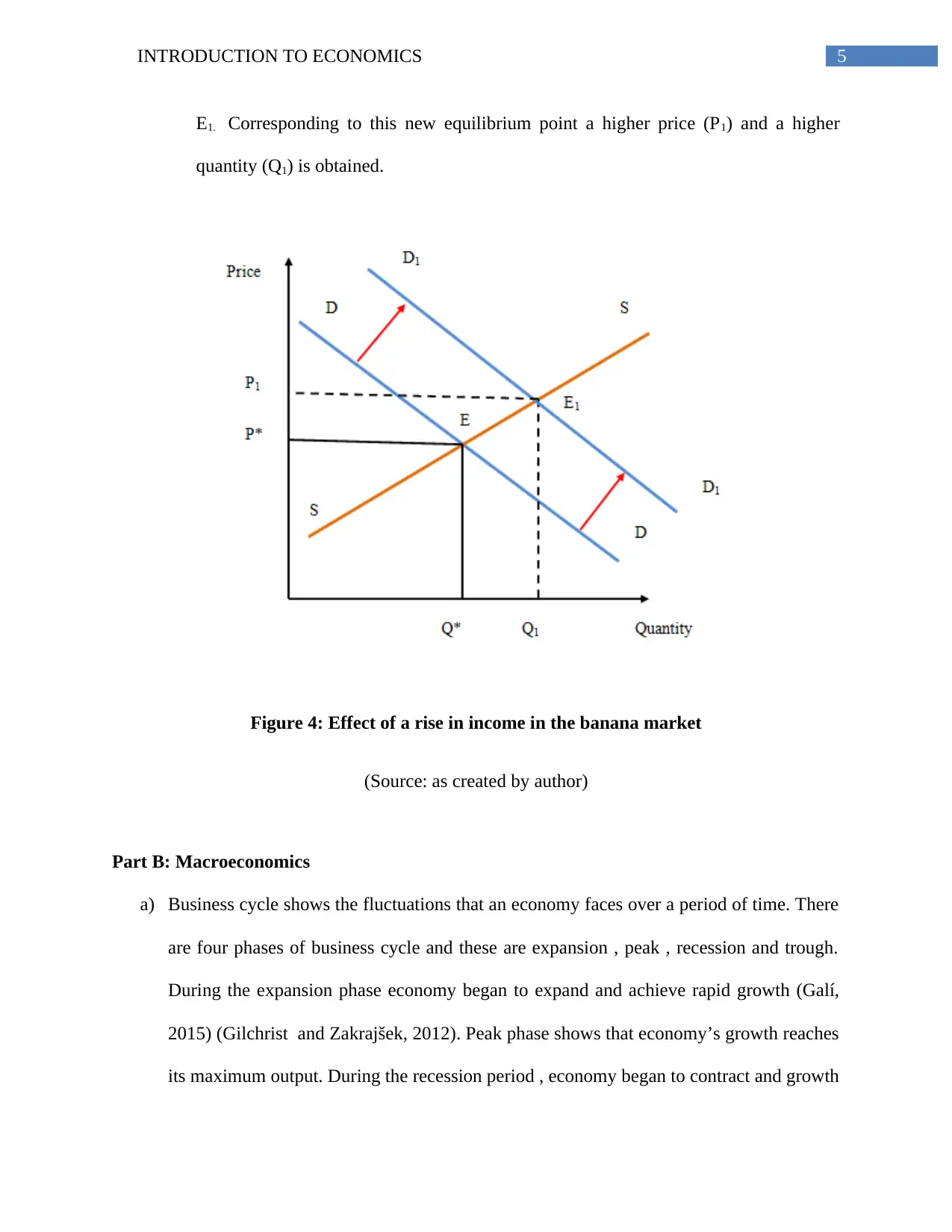
5INTRODUCTION TO ECONOMICS
E1. Corresponding to this new equilibrium point a higher price (P1) and a higher
quantity (Q1) is obtained.
Figure 4: Effect of a rise in income in the banana market
(Source: as created by author)
Part B: Macroeconomics
a) Business cycle shows the fluctuations that an economy faces over a period of time. There
are four phases of business cycle and these are expansion , peak , recession and trough.
During the expansion phase economy began to expand and achieve rapid growth (Galí,
2015) (Gilchrist and Zakrajšek, 2012). Peak phase shows that economy’s growth reaches
its maximum output. During the recession period , economy began to contract and growth
E1. Corresponding to this new equilibrium point a higher price (P1) and a higher
quantity (Q1) is obtained.
Figure 4: Effect of a rise in income in the banana market
(Source: as created by author)
Part B: Macroeconomics
a) Business cycle shows the fluctuations that an economy faces over a period of time. There
are four phases of business cycle and these are expansion , peak , recession and trough.
During the expansion phase economy began to expand and achieve rapid growth (Galí,
2015) (Gilchrist and Zakrajšek, 2012). Peak phase shows that economy’s growth reaches
its maximum output. During the recession period , economy began to contract and growth
⊘ This is a preview!⊘
Do you want full access?
Subscribe today to unlock all pages.

Trusted by 1+ million students worldwide

6INTRODUCTION TO ECONOMICS
becomes slow and finally the trough period shows that economy hits low point in growth
and from this point economy begun to recover.
Figure 1: Business cycle
(Source: Sherman 2014)
In the context of China, the macroeconomic indicators of the country in 2006 indicates
that Chinese economy is in expansion phase and this is due to the fact unemployment during
2006 begins to fall while the inflation figure shows that in the later part of 2006 began to rise .
Thus the economy during 2006 was recovering.
fall and later inflation begins to rise.
a) Aggregate demand shows the total demand of goods and services in an economy within a
particular market. The four components of aggregate demand are : consumption,
investment, government spending and net exports.
becomes slow and finally the trough period shows that economy hits low point in growth
and from this point economy begun to recover.
Figure 1: Business cycle
(Source: Sherman 2014)
In the context of China, the macroeconomic indicators of the country in 2006 indicates
that Chinese economy is in expansion phase and this is due to the fact unemployment during
2006 begins to fall while the inflation figure shows that in the later part of 2006 began to rise .
Thus the economy during 2006 was recovering.
fall and later inflation begins to rise.
a) Aggregate demand shows the total demand of goods and services in an economy within a
particular market. The four components of aggregate demand are : consumption,
investment, government spending and net exports.
Paraphrase This Document
Need a fresh take? Get an instant paraphrase of this document with our AI Paraphraser
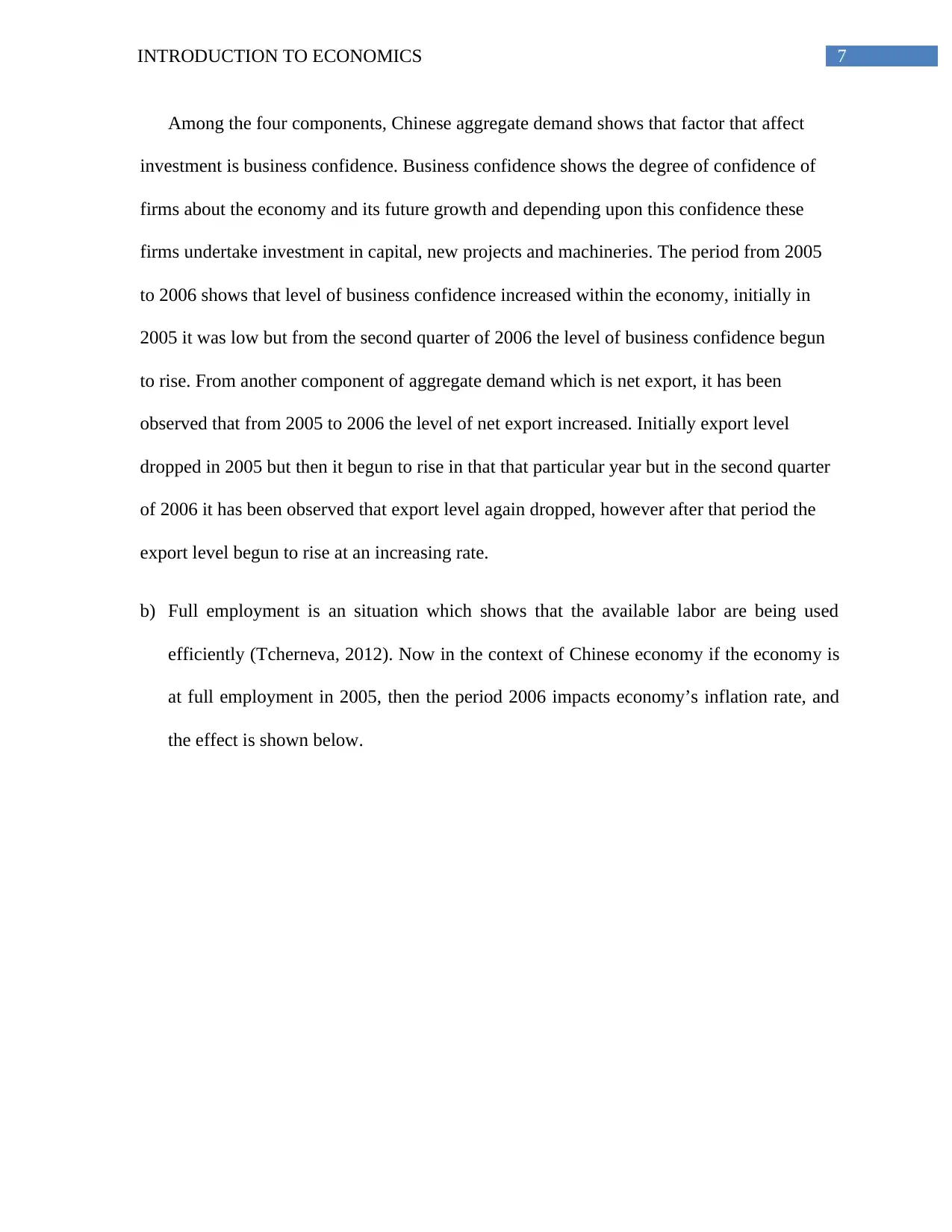
7INTRODUCTION TO ECONOMICS
Among the four components, Chinese aggregate demand shows that factor that affect
investment is business confidence. Business confidence shows the degree of confidence of
firms about the economy and its future growth and depending upon this confidence these
firms undertake investment in capital, new projects and machineries. The period from 2005
to 2006 shows that level of business confidence increased within the economy, initially in
2005 it was low but from the second quarter of 2006 the level of business confidence begun
to rise. From another component of aggregate demand which is net export, it has been
observed that from 2005 to 2006 the level of net export increased. Initially export level
dropped in 2005 but then it begun to rise in that that particular year but in the second quarter
of 2006 it has been observed that export level again dropped, however after that period the
export level begun to rise at an increasing rate.
b) Full employment is an situation which shows that the available labor are being used
efficiently (Tcherneva, 2012). Now in the context of Chinese economy if the economy is
at full employment in 2005, then the period 2006 impacts economy’s inflation rate, and
the effect is shown below.
Among the four components, Chinese aggregate demand shows that factor that affect
investment is business confidence. Business confidence shows the degree of confidence of
firms about the economy and its future growth and depending upon this confidence these
firms undertake investment in capital, new projects and machineries. The period from 2005
to 2006 shows that level of business confidence increased within the economy, initially in
2005 it was low but from the second quarter of 2006 the level of business confidence begun
to rise. From another component of aggregate demand which is net export, it has been
observed that from 2005 to 2006 the level of net export increased. Initially export level
dropped in 2005 but then it begun to rise in that that particular year but in the second quarter
of 2006 it has been observed that export level again dropped, however after that period the
export level begun to rise at an increasing rate.
b) Full employment is an situation which shows that the available labor are being used
efficiently (Tcherneva, 2012). Now in the context of Chinese economy if the economy is
at full employment in 2005, then the period 2006 impacts economy’s inflation rate, and
the effect is shown below.
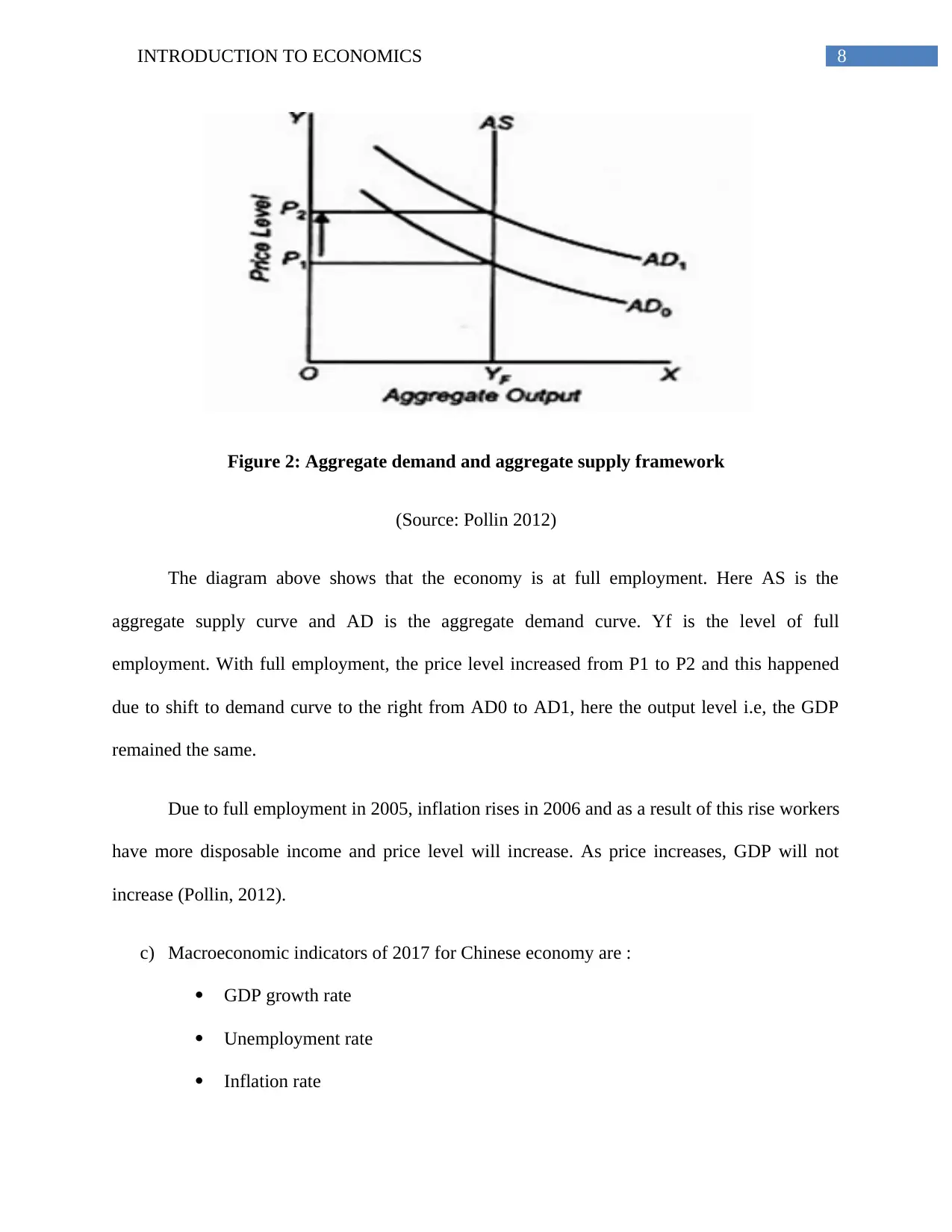
8INTRODUCTION TO ECONOMICS
Figure 2: Aggregate demand and aggregate supply framework
(Source: Pollin 2012)
The diagram above shows that the economy is at full employment. Here AS is the
aggregate supply curve and AD is the aggregate demand curve. Yf is the level of full
employment. With full employment, the price level increased from P1 to P2 and this happened
due to shift to demand curve to the right from AD0 to AD1, here the output level i.e, the GDP
remained the same.
Due to full employment in 2005, inflation rises in 2006 and as a result of this rise workers
have more disposable income and price level will increase. As price increases, GDP will not
increase (Pollin, 2012).
c) Macroeconomic indicators of 2017 for Chinese economy are :
GDP growth rate
Unemployment rate
Inflation rate
Figure 2: Aggregate demand and aggregate supply framework
(Source: Pollin 2012)
The diagram above shows that the economy is at full employment. Here AS is the
aggregate supply curve and AD is the aggregate demand curve. Yf is the level of full
employment. With full employment, the price level increased from P1 to P2 and this happened
due to shift to demand curve to the right from AD0 to AD1, here the output level i.e, the GDP
remained the same.
Due to full employment in 2005, inflation rises in 2006 and as a result of this rise workers
have more disposable income and price level will increase. As price increases, GDP will not
increase (Pollin, 2012).
c) Macroeconomic indicators of 2017 for Chinese economy are :
GDP growth rate
Unemployment rate
Inflation rate
⊘ This is a preview!⊘
Do you want full access?
Subscribe today to unlock all pages.

Trusted by 1+ million students worldwide
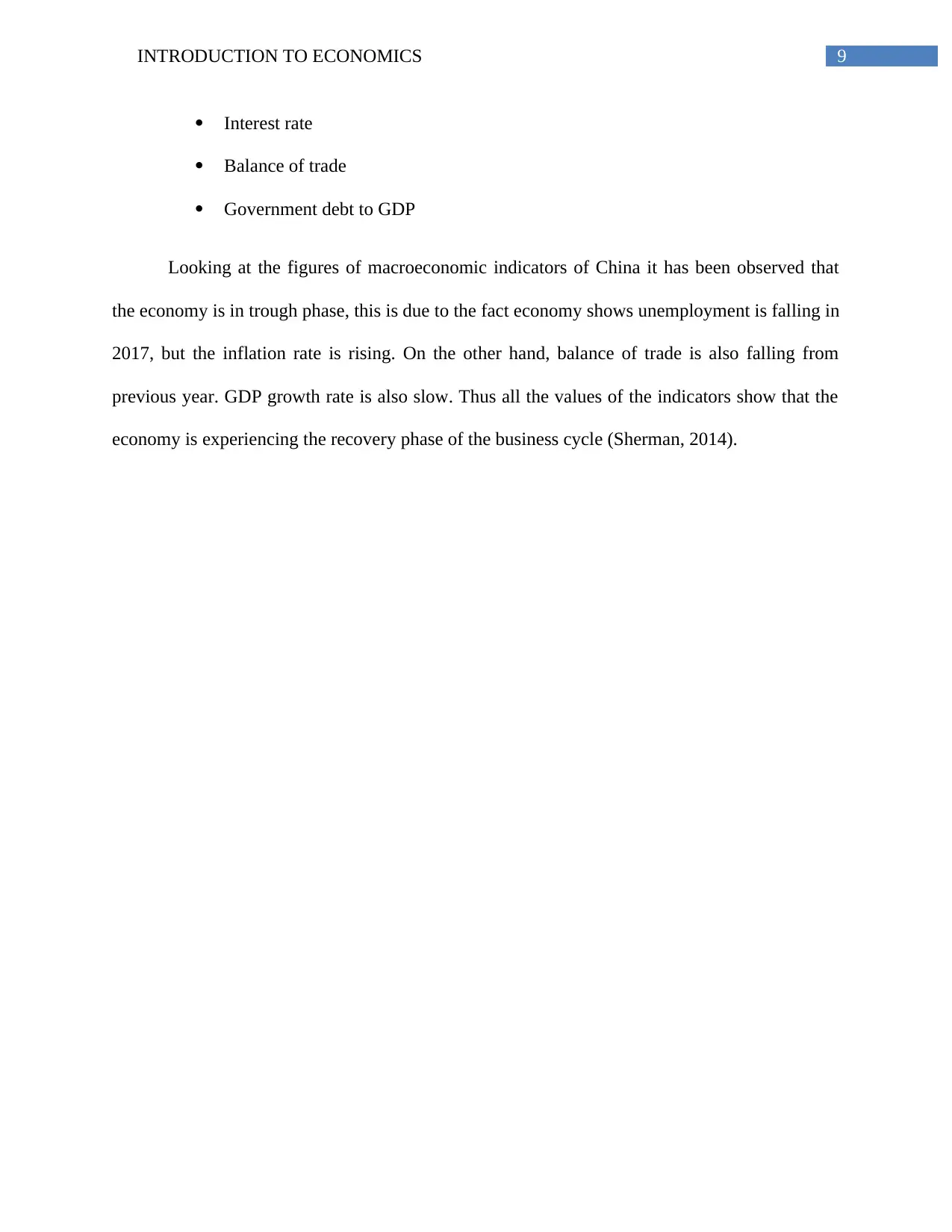
9INTRODUCTION TO ECONOMICS
Interest rate
Balance of trade
Government debt to GDP
Looking at the figures of macroeconomic indicators of China it has been observed that
the economy is in trough phase, this is due to the fact economy shows unemployment is falling in
2017, but the inflation rate is rising. On the other hand, balance of trade is also falling from
previous year. GDP growth rate is also slow. Thus all the values of the indicators show that the
economy is experiencing the recovery phase of the business cycle (Sherman, 2014).
Interest rate
Balance of trade
Government debt to GDP
Looking at the figures of macroeconomic indicators of China it has been observed that
the economy is in trough phase, this is due to the fact economy shows unemployment is falling in
2017, but the inflation rate is rising. On the other hand, balance of trade is also falling from
previous year. GDP growth rate is also slow. Thus all the values of the indicators show that the
economy is experiencing the recovery phase of the business cycle (Sherman, 2014).
Paraphrase This Document
Need a fresh take? Get an instant paraphrase of this document with our AI Paraphraser
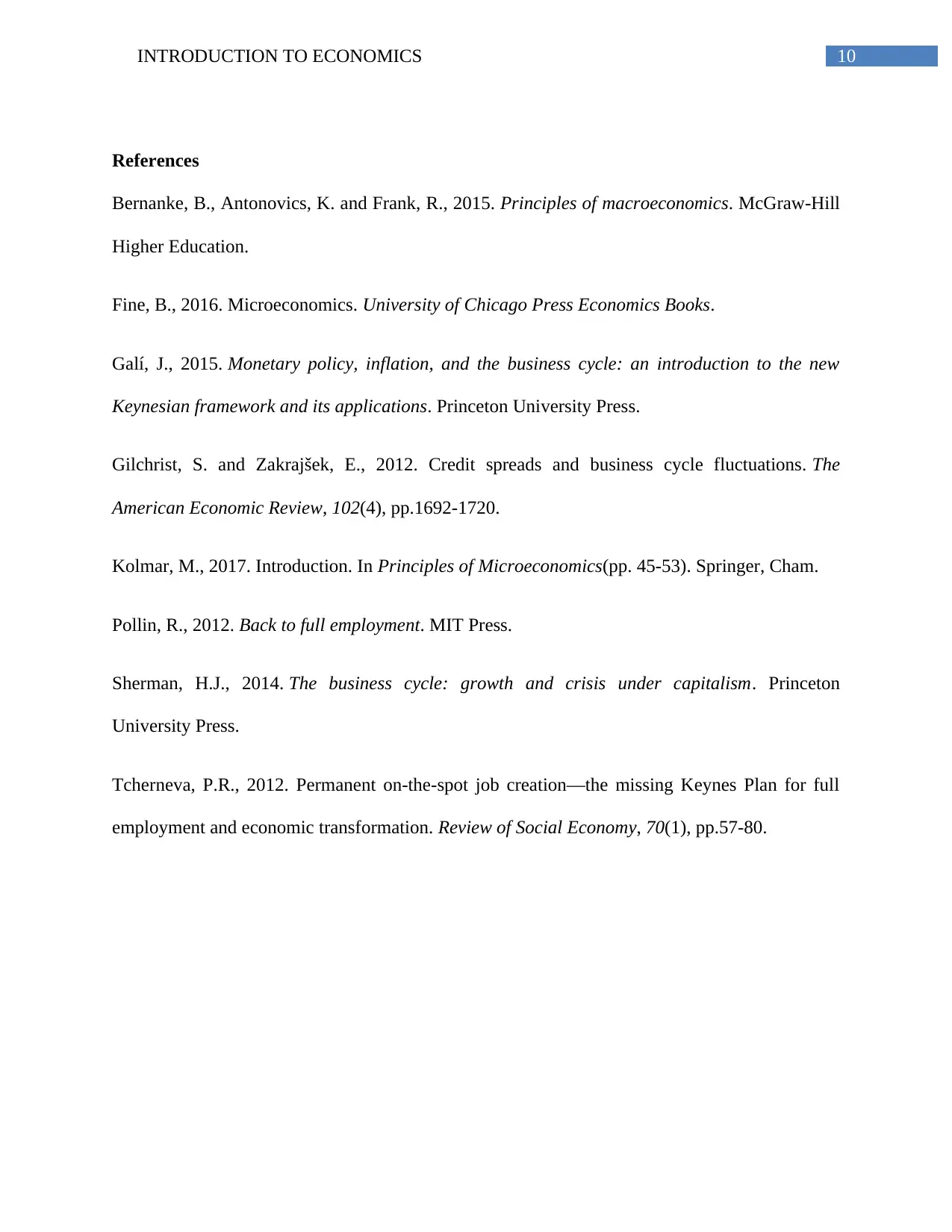
10INTRODUCTION TO ECONOMICS
References
Bernanke, B., Antonovics, K. and Frank, R., 2015. Principles of macroeconomics. McGraw-Hill
Higher Education.
Fine, B., 2016. Microeconomics. University of Chicago Press Economics Books.
Galí, J., 2015. Monetary policy, inflation, and the business cycle: an introduction to the new
Keynesian framework and its applications. Princeton University Press.
Gilchrist, S. and Zakrajšek, E., 2012. Credit spreads and business cycle fluctuations. The
American Economic Review, 102(4), pp.1692-1720.
Kolmar, M., 2017. Introduction. In Principles of Microeconomics(pp. 45-53). Springer, Cham.
Pollin, R., 2012. Back to full employment. MIT Press.
Sherman, H.J., 2014. The business cycle: growth and crisis under capitalism. Princeton
University Press.
Tcherneva, P.R., 2012. Permanent on-the-spot job creation—the missing Keynes Plan for full
employment and economic transformation. Review of Social Economy, 70(1), pp.57-80.
References
Bernanke, B., Antonovics, K. and Frank, R., 2015. Principles of macroeconomics. McGraw-Hill
Higher Education.
Fine, B., 2016. Microeconomics. University of Chicago Press Economics Books.
Galí, J., 2015. Monetary policy, inflation, and the business cycle: an introduction to the new
Keynesian framework and its applications. Princeton University Press.
Gilchrist, S. and Zakrajšek, E., 2012. Credit spreads and business cycle fluctuations. The
American Economic Review, 102(4), pp.1692-1720.
Kolmar, M., 2017. Introduction. In Principles of Microeconomics(pp. 45-53). Springer, Cham.
Pollin, R., 2012. Back to full employment. MIT Press.
Sherman, H.J., 2014. The business cycle: growth and crisis under capitalism. Princeton
University Press.
Tcherneva, P.R., 2012. Permanent on-the-spot job creation—the missing Keynes Plan for full
employment and economic transformation. Review of Social Economy, 70(1), pp.57-80.
1 out of 11
Related Documents
Your All-in-One AI-Powered Toolkit for Academic Success.
+13062052269
info@desklib.com
Available 24*7 on WhatsApp / Email
![[object Object]](/_next/static/media/star-bottom.7253800d.svg)
Unlock your academic potential
Copyright © 2020–2025 A2Z Services. All Rights Reserved. Developed and managed by ZUCOL.





